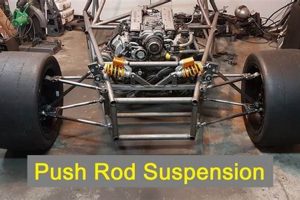Constructing audio reproduction devices at home involves assembling individual components to create a complete sound system. This practice allows for customization and potentially cost-effective solutions when compared to purchasing commercially manufactured units. An example of this is building speaker enclosures, wiring drivers, and implementing crossover networks independently.
The practice offers considerable advantages, including the ability to tailor sonic characteristics to specific listening environments or personal preferences. Historically, this approach was driven by a need to access high-quality audio components not readily available in mass-produced systems. The result can be a sound system perfectly suited to the listener’s ears as well as a sense of accomplishment upon completion.
The following information will detail aspects of driver selection, enclosure design principles, crossover implementation, and finishing techniques essential for achieving optimal performance when building customized sound systems.
Essential Guidance for Home Audio System Construction
The successful creation of custom audio systems hinges on careful planning and execution. Several key areas demand attention to ensure optimal performance and longevity.
Tip 1: Driver Selection: Choosing appropriate drivers requires a clear understanding of the intended frequency range and listening environment. Analyze driver specifications, including frequency response, sensitivity, and power handling, to match components effectively.
Tip 2: Enclosure Volume and Damping: Precise internal volume is crucial for achieving desired low-frequency response. Experiment with various damping materials (e.g., fiberglass, acoustic foam) to mitigate unwanted internal resonances.
Tip 3: Crossover Design: Employ a well-designed crossover network to distribute frequencies optimally between drivers. Utilize simulation software to model crossover behavior and component values prior to physical assembly.
Tip 4: Cabinet Construction: Sturdy construction is paramount for minimizing unwanted vibrations and resonances. Utilize dense materials, such as medium-density fiberboard (MDF), and ensure rigid joints.
Tip 5: Wiring and Connections: Employ high-quality wiring and connectors to minimize signal loss and ensure reliable connections. Solder connections where appropriate to improve conductivity and durability.
Tip 6: Measurement and Tuning: After assembly, perform acoustic measurements to evaluate performance characteristics. Adjust crossover components or enclosure damping as needed to optimize frequency response and imaging.
Tip 7: Finishing Techniques: Apply durable and aesthetically pleasing finishes to protect the enclosure and enhance visual appeal. Consider various options, such as veneer, paint, or textured coatings.
By adhering to these guidelines, builders can significantly increase the likelihood of creating high-performance sound systems that meet their specific needs and preferences. Careful attention to detail in each stage of the building process is key.
The subsequent sections will delve into further details on specific building techniques, component sourcing, and troubleshooting strategies to enable more individuals to pursue this rewarding pursuit successfully.
1. Driver Selection
Driver selection constitutes a foundational element in the successful construction of customized audio reproduction systems. The characteristics of the chosen drivers directly influence the achievable frequency response, distortion levels, and overall sonic signature. In effect, selecting inappropriate drivers can negate the benefits of meticulous enclosure design and crossover implementation. For instance, using a tweeter with limited low-frequency extension in a two-way system necessitates a higher crossover point, potentially compromising midrange clarity. Conversely, selecting a woofer with excessive distortion at higher frequencies negatively impacts the overall sonic experience.
The practical significance of informed driver selection becomes evident when considering specific project goals. A system intended for home theater applications necessitates drivers capable of high output and controlled directivity, while a system designed for critical listening benefits from drivers with exceptionally low distortion and accurate frequency response. The driver selection process must consider various technical specifications, including Thiele/Small parameters for woofers, frequency response curves, and power handling capabilities. Analyzing these specifications, in conjunction with the intended application, allows for informed decisions that optimize system performance. For example, selecting a subwoofer driver with a low Fs (resonant frequency) and high excursion capability enables the reproduction of deep bass frequencies at substantial sound pressure levels.
Ultimately, driver selection is not merely a component of building individualized audio systems; it is the single most important factor to the final output and clarity. The chosen drivers dictate the performance ceiling of the entire system. Careful consideration of driver specifications, project goals, and the interplay between drivers and other system components is crucial for achieving desired sonic characteristics. The complexity of the selection process underscores the importance of a thorough understanding of audio engineering principles and driver characteristics.
2. Enclosure Design
Enclosure design profoundly influences the acoustic performance of home-built loudspeakers. The enclosure serves as more than a housing for drivers; it actively shapes the generated sound waves. Its dimensions and geometry directly impact frequency response, particularly in the low-frequency range. A poorly designed enclosure can introduce unwanted resonances, causing coloration of the sound. A properly designed enclosure, conversely, reinforces desired frequencies, extending the bass response and improving overall sound quality. The physical volume of the enclosure, vent dimensions (in ported designs), and internal damping materials each contribute to the final acoustic output.
The practical significance of enclosure design is evident in comparing sealed and ported enclosures. A sealed enclosure offers a gradual roll-off in bass response, characterized by tight and controlled bass reproduction. This design choice is often favored in applications where accuracy and transient response are paramount. Ported enclosures, on the other hand, utilize a vent to reinforce bass frequencies around the port’s tuning frequency. While potentially delivering deeper bass extension, ported designs require careful calculations to avoid over-excursion of the woofer and potential distortion. An example is a transmission line enclosure. It uses a long, internally folded pathway to delay and phase-invert the rear wave of the spea
ker driver to reinforce the front wave, notably improving bass response.
Effective enclosure design necessitates a comprehensive understanding of acoustics and cabinet construction. Challenges include mitigating internal standing waves, selecting appropriate damping materials, and ensuring structural integrity. Without a well-engineered enclosure, even the highest-quality drivers will fail to deliver their full potential. Therefore, enclosure design stands as a critical element in the success of any home-built audio system, acting as a bridge between individual components and cohesive sound reproduction. Further study into specific enclosure types and simulation software is highly recommended.
3. Crossover Network
The crossover network constitutes a critical element within the design and implementation of individualized audio systems. Its primary function is to divide the audio signal into distinct frequency ranges, directing each range to the appropriate driverwoofer, midrange, or tweeteroptimized for its reproduction. Without a properly designed crossover, drivers would attempt to reproduce frequencies beyond their capabilities, leading to distortion, reduced efficiency, and potential damage. Therefore, the crossover network acts as a signal management system, ensuring each driver operates within its optimal range. This division of labor is crucial for achieving accurate and balanced sound reproduction within individualized audio solutions.
The practical significance of understanding crossover networks becomes apparent when considering the variety of design options available. Passive crossovers, implemented with resistors, capacitors, and inductors, are commonly employed in individualized audio systems due to their simplicity and lack of external power requirements. However, their performance is inherently limited by component tolerances and impedance variations. Active crossovers, utilizing operational amplifiers and filters, offer greater flexibility and precision but necessitate external power amplification for each frequency band. An example involves a two-way individualized audio system: A passive crossover might employ a simple first-order filter to separate frequencies, while an active crossover could utilize a fourth-order Linkwitz-Riley filter for steeper attenuation and improved driver integration. The choice between passive and active designs depends on factors such as budget, desired performance level, and design complexity.
Successfully implementing a crossover network demands an understanding of filter topologies, component selection, and impedance matching. Challenges include minimizing phase distortion, achieving seamless driver integration, and ensuring the crossover network is compatible with the drivers and enclosure. The impact of the crossover network on the overall sonic performance of a individualized audio system cannot be overstated. It is the central element, ensuring the drivers operate harmoniously and contribute to an accurate and enjoyable listening experience. Therefore, a solid grasp of crossover network design principles is essential for anyone seeking to create high-quality, custom-built audio systems.
4. Cabinet Assembly
Cabinet assembly forms a crucial stage in the realization of individualized audio systems. It is the physical manifestation of the carefully considered enclosure design, translating theoretical calculations into a tangible structure. The precision and integrity of the cabinet assembly directly impact the acoustic output, influencing factors such as resonance, diffraction, and overall sound quality. A poorly assembled cabinet, characterized by loose joints or inadequate bracing, introduces unwanted vibrations and distorts the intended sound reproduction. Consider, for example, a cabinet constructed with insufficient bracing: the cabinet walls vibrate in sympathy with the driver, muddying the sound and reducing clarity. The connection is causative: faulty assembly directly leads to degraded audio performance. Real-world instances show a cabinet constructed of MDF (Medium-Density Fiberboard) where screws alone were used and glue wasn’t added: the cabinet panels would separate under the vibrations created, especially during bass-heavy passages, greatly diminishing the audio quality produced. Conversely, a robust and well-sealed cabinet provides a stable platform for the drivers, allowing them to operate at their optimal performance level.
Beyond structural integrity, cabinet assembly techniques also influence the aesthetic appeal of the individualized audio system. Precise cuts, flush joints, and careful attention to detail contribute to a professional and visually pleasing finished product. Various construction methods exist, ranging from simple butt joints to more complex techniques such as rabbet or dado joints, each offering varying degrees of strength and aesthetic refinement. The selection of appropriate adhesives and fasteners also plays a significant role. For instance, using a high-quality wood glue and clamping the cabinet during assembly ensures a strong and airtight bond, minimizing the risk of leaks or vibrations. The application of edge banding or veneer further enhances the visual appearance, creating a seamless and polished look. The choice of finish, whether paint, stain, or lacquer, completes the aesthetic transformation, allowing the builder to personalize the cabinet to match their individual preferences and home decor.
In summary, cabinet assembly is an indispensable process in building individualized audio systems, bridging the gap between design and audible reality. It presents challenges requiring both technical skill and meticulous execution. The strength and precision of the assembly directly influence both acoustic performance and visual appeal. A solid understanding of cabinet construction techniques, material properties, and finishing methods is therefore essential for anyone seeking to create high-quality, individualized audio reproduction systems.
5. Finishing Techniques
Finishing techniques represent a critical phase in the construction of individualized audio systems, directly impacting both the aesthetic appeal and the long-term durability of the speaker enclosure. The chosen finish acts as a protective barrier against moisture, ultraviolet radiation, and physical abrasions, thereby extending the lifespan of the cabinet. Furthermore, the finish can influence the acoustic performance of the speaker, minimizing unwanted resonances and diffraction effects. Consider an unfinished MDF cabinet: the porous nature of the material renders it susceptible to moisture absorption, leading to swelling and deformation over time. The lack of a protective coating also makes the cabinet vulnerable to scratches and dents, compromising its visual integrity. In contrast, a properly applied finish provides a durable and aesthetically pleasing surface, enhancing the overall value and longevity of the individualized audio system.
The practical significance of understanding finishing techniques becomes evident when considering the variety of options available. Veneering, painting, staining, and lacquering each offer distinct advantages and disadvantages in terms of cost, durability, and aesthetic appeal. Veneering, for example, involves applying a thin lay
er of real wood to the cabinet surface, providing a high-end look and feel. However, it requires specialized skills and tools to achieve a seamless and professional result. Painting offers a cost-effective and versatile option, allowing for a wide range of colors and textures. However, proper surface preparation and application techniques are essential to avoid imperfections such as brush strokes or orange peel. Staining enhances the natural grain of the wood, adding warmth and character. However, it requires careful selection of the appropriate stain color and application method to achieve the desired effect. Lacquering provides a durable and glossy finish, offering excellent protection against scratches and moisture. However, it requires specialized equipment and ventilation due to the hazardous nature of the materials. Instances from personal experience show a speaker that lacked sufficient layers of clear coating. The result was it faded and started to become damaged, even from regular sunlight.
Effective finishing techniques require a thorough understanding of material properties, surface preparation, and application methods. Challenges include achieving a smooth and even finish, preventing runs or sags, and ensuring proper adhesion. Careful sanding, priming, and masking are crucial steps in the finishing process. The choice of finish should also consider the intended use and environment of the speaker. For instance, a speaker intended for outdoor use requires a more durable and weather-resistant finish than a speaker intended for indoor use. In conclusion, the application of appropriate finishing techniques is an indispensable element in the successful construction of individualized audio systems, significantly contributing to both their aesthetic appeal and their functional longevity.
Frequently Asked Questions
The following addresses common inquiries regarding the construction of individualized audio solutions. The intent is to provide clear and concise answers based on established audio engineering principles.
Question 1: What are the primary advantages of constructing custom sound systems versus purchasing commercially manufactured units?
Building individualized audio systems offers several key advantages, including the ability to tailor sonic characteristics to specific listening environments and personal preferences. It also potentially lowers costs by sourcing individual components. Finally, it provides a sense of accomplishment and deeper understanding of audio engineering principles.
Question 2: How important is enclosure volume to the overall sound quality?
Enclosure volume significantly impacts the low-frequency response of the speaker. Precise volume calculations are crucial for achieving desired bass extension and minimizing unwanted resonances. Deviations from the optimal volume can result in inaccurate or muddy bass reproduction.
Question 3: What role does the crossover network play in a multi-driver system?
The crossover network divides the audio signal into different frequency ranges, directing each range to the appropriate driver (e.g., woofer, tweeter). This prevents drivers from attempting to reproduce frequencies beyond their capabilities, reducing distortion and improving overall sound quality.
Question 4: What materials are best suited for constructing speaker enclosures?
Medium-density fiberboard (MDF) is a commonly used material due to its density, stability, and ease of machining. Other suitable materials include plywood and Baltic birch, although these may be more expensive. The chosen material should be rigid and non-resonant to minimize unwanted vibrations.
Question 5: Is acoustic damping necessary, and if so, what materials are recommended?
Acoustic damping is generally necessary to absorb internal sound reflections and minimize standing waves within the enclosure. Recommended damping materials include fiberglass, acoustic foam, and mineral wool. The appropriate amount of damping material depends on the enclosure volume and driver characteristics.
Question 6: How can one troubleshoot common problems encountered during the construction process?
Common problems include wiring errors, incorrect crossover component values, and air leaks in the enclosure. Careful inspection, multimeter testing, and acoustic measurements are essential for identifying and resolving these issues. Simulation software can also aid in diagnosing crossover-related problems.
In conclusion, meticulous attention to detail and a thorough understanding of audio engineering principles are essential for successful construction of individualized audio solutions. Addressing the questions above provides a solid foundation for pursuing this rewarding pursuit.
Further exploration into advanced construction techniques and component selection is recommended for those seeking to push the boundaries of performance and customization.
diy loudspeakers
This exploration has detailed the critical aspects of constructing individualized audio systems. From driver selection to finishing techniques, each stage demands precision and informed decision-making. Successfully navigating these complexities requires a commitment to understanding audio principles and careful execution of the construction process. The result, however, is an audio system tailored to specific needs and preferences, offering potential advantages in both sonic performance and cost-effectiveness compared to commercially available options.
The pursuit of building individualized audio systems offers significant rewards. It allows for unparalleled customization, control over component quality, and a deeper appreciation for audio engineering. Continued research and experimentation remain essential for advancing the state of the art in this field, enabling further improvements in sonic accuracy and aesthetic design. The pursuit of building individualized audio systems is to be continued.







